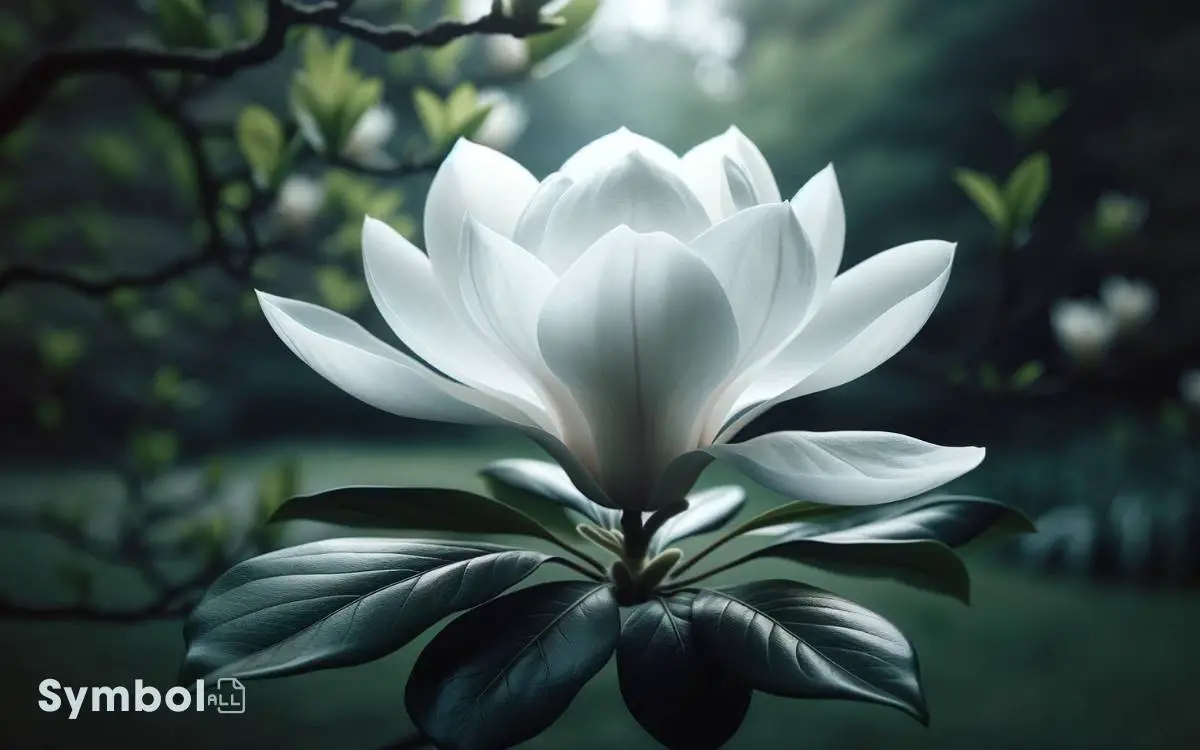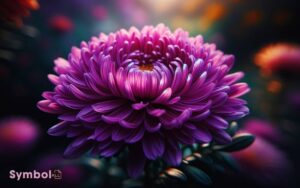What Does the Magnolia Flower Symbolize? Nobility!
The magnolia flower symbolizes nobility, embodying dignity and splendor. It’s linked with purity and innocence, reflecting timeless values.
You’ll find it represents perseverance and resilience, illustrating a graceful strength often associated with femininity. Additionally, it conveys the strength and durability of love, traits cherished across cultures.
Originating over 95 million years ago, this ancient species has adapted to diverse climates, supporting wildlife and attracting pollinators with its large, fragrant flowers.
Revered in ancient and modern times, the magnolia’s symbolism extends to purity, renewal, and overcoming challenges.
Unraveling its layers reveals deeper insights into its enduring significance across various cultures and traditions.

Key Takeaways
The Origin of Magnolias
Magnolias, one of the most ancient flowering plant species, originated over 95 million years ago, predating even bees in the evolutionary timeline. This fact alone highlights their resilience and adaptability.
Found across Asia and the Americas, magnolias have thrived through dramatic climatic shifts, showcasing an incredible ability to survive and evolve.
They’re known for their large, aromatic flowers, which, remarkably, evolved to attract pollinating beetles, as bees weren’t yet present.
This evolutionary adaptation underscores the magnolia’s significance in understanding plant pollination’s history.
Their diverse genus, with over 200 species, exhibits a wide range of flower colors, shapes, and sizes, each adapted to specific environmental conditions. Your appreciation for magnolias deepens when you grasp their ancient origins and evolutionary achievements.
Symbol of Nobility
Throughout history, the magnolia flower has symbolized nobility, embodying qualities of dignity and splendor across various cultures.
This association isn’t accidental; the magnolia’s grandeur, with its large, imposing flowers and robust form, naturally evokes a sense of regality and grace.
Scientifically, Magnolia spp. possess unique characteristics that set them apart in the plant kingdom, including their ancient lineage, which dates back millions of years, predating even bees. This longevity and resilience mirror the enduring and steadfast nature of noble ideals.
Culturally, magnolias have been revered in royal gardens and used in regal symbolism, further reinforcing their connection to nobility. They’re not just plants; they’re living symbols of strength, permanence, and the lofty ideals that have guided human civilizations.
Representation of Purity
You’ll find that the magnolia flower‘s representation of purity stems from its symbolic meanings and cultural significance.
Researchers have documented its role in various cultures as a symbol of innocence and cleanliness, which you’ll explore in the following sections.
This exploration will disclose the depth of the magnolia’s purity through scientific analysis and historical context.
Symbolic Meanings Explained
In exploring the symbolic meanings of the magnolia flower, its representation of purity stands out as a significant attribute.
| Attribute | Explanation |
|---|---|
| Color | The pristine white color of many magnolia blossoms symbolizes purity and innocence, reflecting a clean, unblemished state. |
| Form | With its large, unbroken petals, the magnolia flower embodies wholeness and perfection, further underscoring its purity. |
| Essence | The magnolia’s enduring and unyielding nature, often the first to bloom and last to wilt, represents the purity of enduring values and the resilience of true beauty. |
This symbolism isn’t just a matter of aesthetics; it’s deeply ingrained in the magnolia’s botanical characteristics and life cycle, making the flower a potent symbol of purity across various contexts.
Cultural Significance Unveiled
Delving into the magnolia flower‘s cultural significance reveals its portrayal as a symbol of purity across numerous traditions.
This emblematic representation is deeply rooted in the flower’s inherent characteristics its pristine white petals and enduring nature.
Scientifically, the magnolia’s resilience is attributed to its ancient lineage, with fossil records indicating its presence over 100 million years ago.
This longevity reflects a purity that transcends temporal fluctuations, embodying an unblemished and unaltered essence through time.
Culturally, its association with purity is often linked to spiritual and ceremonial practices. For example, in East Asian traditions, magnolias are frequently used in temple offerings, symbolizing the purity of the soul and intentions.
This multifaceted symbol’s purity aspect seamlessly bridges natural resilience with profound cultural reverence, offering a nuanced understanding of its significance.
Emblems of Perseverance
Amidst the challenges of harsh climates and poor soils, the magnolia flower stands as a symbol of perseverance, showcasing its ability to thrive under adverse conditions. This resilience isn’t accidental but a result of millions of years of evolution.
The magnolia’s lineage, dating back to the Cretaceous period, has equipped it with features to withstand environmental stress. Its waxy leaves and robust petals aren’t just aesthetic; they’re functional adaptations for survival.
These characteristics enable the magnolia to conserve water and protect against pests, ensuring its growth and reproduction even in less than ideal circumstances.
When you observe a magnolia, you’re witnessing a demonstration of endurance and adaptability, a living example of nature’s tenacity.
Femininity and the Magnolia
You’ll find that the magnolia flower embodies a symbol of graceful strength, highlighting its historical feminine associations.
This connection isn’t merely aesthetic but deeply rooted in cultural narratives that associate its enduring beauty with resilience in femininity.
Studies and folklore alike explore how the magnolia’s elegance and durability mirror traits traditionally admired in women, offering a rich tapestry of meaning to unravel.
Symbol of Graceful Strength
The magnolia flower embodies graceful strength, symbolizing femininity through its enduring and delicate appearance.
You’ll find its resilience remarkable; despite its soft, velvety petals, the magnolia thrives in diverse climates, from the cool temperatures of the high mountains to the warm, humid conditions of tropical zones.
This adaptability reflects a potent metaphor for the strength and grace often associated with femininity.
Its broad, glossy leaves and stout branches further illustrate its robustness, supporting the weight of large, fragrant blossoms.
The magnolia’s ability to withstand harsh environments while maintaining its elegance makes it a powerful emblem of the balance between resilience and beauty, capturing the essence of feminine strength in the natural world.
Historical Feminine Associations
Magnolia flowers have long been associated with femininity, tracing back to ancient civilizations where they symbolized purity and nobility in women. This connection has evolved, but the core meanings remain significant in various cultural contexts.
Here are key points to understand:
- In many cultures, magnolias represent the beauty and gentleness traditionally associated with femininity.
- Their long history of cultivation has seen them become emblems of women’s enduring strength and dignity.
- The magnolia’s diverse species echo the variety of ways femininity is expressed and celebrated across societies.
- Scientifically, the resilience and longevity of magnolia trees parallel historical perceptions of women’s roles as both nurturers and leaders.
Understanding these associations enriches our appreciation of the magnolia’s symbolism and its enduring connection to femininity.
Beauty in Resilience
Resilience, often mirrored in the enduring beauty of magnolia flowers, highlights a profound connection to aspects of femininity celebrated across cultures.
These blooms, with their robust petals and ability to thrive in challenging environments, symbolize the strength and grace inherent in the feminine spirit.
Scientific studies have shown that magnolias have evolved over millions of years, developing unique characteristics to survive in changing climates.
This evolutionary resilience is paralleled in the societal role of women, who’ve historically adapted to and overcome various adversities.
The magnolia’s beauty, thus, isn’t just aesthetic. It embodies the resilience and adaptability of women, serving as a natural metaphor for the enduring and transformative power of femininity.
Through this lens, magnolias inspire admiration and a deeper understanding of the strength within vulnerability.
Connection to Nature
In exploring the meaning of the magnolia flower, it’s important to recognize its profound connection to nature, serving as a symbol of both beauty and strength in diverse ecosystems.
This connection underscores the magnolia’s significance:
- Ecological Role: Magnolias contribute to their habitats by providing food and shelter for wildlife, showcasing the interconnectedness of nature.
- Longevity: Some magnolia trees can live for over a century, embodying the enduring aspect of the natural world.
- Pollination: Their large, fragrant flowers attract pollinators, playing an essential role in the reproductive systems of ecosystems.
- Adaptability: Magnolias have adapted to various climates and conditions, reflecting nature’s resilience and versatility.
Understanding the magnolia’s connection to nature enriches our appreciation of its symbolic value, blending scientific insight with cultural significance.
The Magnolia in Ancient Cultures
Throughout history, various ancient cultures have revered the magnolia flower, attributing to it profound meanings and uses that reflect its significance in human society.
In ancient China, magnolias were seen as symbols of purity and nobility, often planted in royal gardens. The Chinese also utilized magnolia bark and flowers for medicinal purposes, leveraging their properties to treat a variety of ailments.
Similarly, in Japan, the magnolia was associated with the natural beauty of spring, representing renewal and perseverance. These societies intricately linked the magnolia’s elegant appearance and enduring nature with cultural values and traditions.
Spiritual Significance
You’ll find that the magnolia flower carries a profound spiritual significance, symbolizing ancient purity, renewal, and hope across various cultures.
Its resilience and the ability to bloom from bare branches represent a powerful metaphor for enduring faith and the rejuvenation of the spirit.
This emblematic flower’s association with such universal themes underscores its enduring appeal and significance in spiritual contexts.
Ancient Purity Symbol
Magnolias have long embodied the concept of purity in various spiritual traditions, serving as symbols of innocence and untainted beauty.
Their longstanding significance is rooted in characteristics that align with purity:
- The magnolia’s pristine white petals symbolize cleanliness and virtue.
- Its enduring nature, with some species thriving for millions of years, represents the timeless aspect of purity.
- The flower’s fragrance, often associated with nobility and dignity, adds another layer to its symbolism of untainted beauty.
- Its early spring bloom, before the leaves appear, signifies a fresh start or beginning, unmarred by the complexities of the world.
Understanding the magnolia’s symbolism offers insights into how cultures have historically valued purity and incorporated natural elements into their spiritual beliefs.
Renewal and Hope
In many cultures, the magnolia flower symbolizes renewal and hope, embodying the spirit of rebirth and the promise of new beginnings. This symbolic meaning is deeply rooted in the flower’s biological characteristics.
Magnolias are among the earliest flowering plants, with fossils dating back over 95 million years. Their resilience and ability to adapt to changing environments underscore their association with renewal.
As spring arrives, magnolia trees burst into bloom, shedding their old leaves for fresh, vibrant flowers.
This natural cycle mirrors the human experience of overcoming challenges and emerging stronger.
Consequently, the magnolia’s blooming represents not just a change in seasons but also a spiritual awakening, encouraging you to embrace change with optimism and resilience.
Magnolias and Love
Throughout history, people have associated magnolia flowers with love and perseverance due to their enduring and resilient nature.
This symbolic connection stems from several key aspects:
- *Magnolia trees can withstand harsh conditions*, symbolizing the strength and durability of love through trials.
- *Their large, conspicuous flowers* represent the grandeur and beauty of love in full bloom.
- *The long lifespan of magnolia trees* mirrors the long-lasting nature of true love and commitment.
- *Magnolias bloom boldly and prominently*, suggesting the courage it takes to love openly and passionately.
Understanding these symbols can deepen your appreciation for magnolias beyond their aesthetic appeal. These flowers encapsulate the complexity, beauty, and resilience of love, making them a profound emblem in various cultural contexts.
The Magnolia in Modern Times
Today, the magnolia flower has blossomed into a symbol of both elegance and resilience, finding its place in modern culture, gardens, and scientific studies alike.
In contemporary gardens, you’ll find magnolias celebrated for their large, fragrant blooms that serve as early spring heralds.
Horticulturists have developed numerous cultivars to suit various climates and landscape designs, showcasing the plant’s adaptability and aesthetic appeal.
Scientifically, magnolias offer a window into the past. Being among the earliest flowering plants, their study provides insights into plant evolution and the ecological dynamics of ancient ecosystems.
Researchers focus on magnolia’s unique pollination mechanisms, which predate the evolution of bees, and its medicinal properties, which have been harnessed in traditional medicine practices across the world.
This blend of beauty and science underscores the magnolia’s enduring relevance in modern times.
Magnolias in Art and Literature
Magnolias have captivated artists and writers, symbolizing purity and perseverance through their elegant representation in various artworks and literary pieces.
This fascination isn’t merely aesthetic but deeply rooted in the magnolia’s biological and cultural significance.
Here’s how magnolias have been celebrated:
- Paintings often depict magnolias with precise botanical details, emphasizing their unique structure and vibrant colors.
- Poetry frequently uses magnolias as metaphors for resilience and beauty, drawing parallels between the flower’s life cycle and human experiences.
- Novels set in the American South utilize magnolias as symbols of the region’s complex history and natural beauty.
- In sculpture, magnolias are carved with meticulous attention to detail, capturing their delicate appearance and evoking a sense of tranquility.
These artistic expressions underscore the magnolia’s multifaceted symbolism, enriching our cultural and scientific appreciation of this remarkable flower.
Healing Properties
Beyond their aesthetic appeal, magnolias harbor healing properties that have been utilized in traditional medicine for centuries.
These properties stem from various parts of the plant, including the bark, flowers, and leaves. They’ve been tapped for their ability to alleviate certain conditions, contributing to both physical and mental wellness.
Here’s a concise table showcasing some of these properties:
| Part of Magnolia | Healing Property |
|---|---|
| Bark | Reduces anxiety and stress |
| Flowers | Alleviates respiratory conditions |
| Leaves | Lowers fever |
| Extract | Antioxidant properties |
| Seeds | Supports cardiovascular health |
This table offers a glimpse into the multifaceted healing capabilities of magnolias, underscoring their importance beyond mere beauty.
These attributes have cemented magnolias as a staple in the domain of natural remedies, providing a reliable source for health and well-being.
Magnolias Around the World
While exploring the healing properties of magnolias, it’s fascinating to observe how these remarkable flowers have made their mark across various cultures around the globe.
Their global presence underscores not only their beauty but also their significance in different traditions and scientific fields.
Here’s how magnolias are perceived worldwide:
- In East Asia, magnolias are symbols of purity and nobility, deeply embedded in traditional ceremonies.
- North American species, like the Southern Magnolia, are famed for their large, aromatic flowers, contributing to local ecosystems.
- European gardeners admire magnolias for their ancient lineage, valuing them as living fossils in botanical collections.
- In traditional medicine practices across South America, magnolia extracts are sought after for their purported therapeutic benefits, highlighting the flower’s global appeal in natural healing.
This widespread reverence underscores the magnolia’s universal allure and its enduring significance across cultures.
Conclusion
In wrapping up, it’s fascinating to note that there are over 200 species of magnolia, each carrying its unique symbolism of nobility, purity, perseverance, and femininity.
This diversity not only underscores the flower’s global significance but also its adaptability and resilience across different cultures and climates.
As you’ve seen, from ancient traditions to modern interpretations, the magnolia’s enduring appeal lies in its profound ability to inspire and heal, making it a timeless emblem in both nature and human society.






